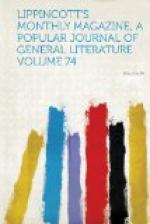Indigo itself had a very arduous series of toils to encounter before it could manage to assert itself in the world. The ardent advocates of its azure rival, woad, struggled long before they would allow its adoption. In 1577 the German government officially prohibited the use of indigo, denouncing it as that pernicious, deceitful and corrosive substance, the Devil’s dye. It had, indeed, a worse fate in England, where hard names were supplemented by harsh acts, for in 1581 it was not only pronounced anathema maranatha by act of Parliament, but the people were authorized to institute search for it in their neighbors’ dye-houses, and were empowered to destroy it wherever found. Not more than two hundred years have passed since this law was still in force. It was only after a determined effort, which involved steady losses for many years, that the East India Company succeeded in re-establishing the culture of indigo in Bengal. The Spanish and French in Central America and the West Indies had come to be large growers, and the production of St. Domingo was very large. But the revolt in the latter island, the Florida disasters and the continual unsettlement of Mexico, all worked favorably for the planters of India, who may now be called the indigo-producers of the world.
[Illustration: MALERS AND SONTALS.]
The seed is usually sown in the latter part of October in Bengal, as soon as the annual deposit of the streams has been reduced by drainage to a practicable consistency, though the sowing-season lasts quite on to the end of November. On dry ground the plough is used, the ryots, or native farm-laborers, usually planting under directions proceeding from the factory. There are two processes of extracting the dye, known as the method “from fresh leaves” and that “from dry leaves.” I found them here manufacturing by the former process. The vats or cisterns of stone were in pairs, the bottom of the upper one of each couple being about on a level with the top of the lower, so as to allow the liquid contents of the former to run freely into the latter. The upper is the fermenting vat, or “steeper,” and is about twenty feet square by three deep. The lower is the “beater,” and is of much the same dimensions with the upper, except that its length is five or six feet greater. As the twigs and leaves of the plants are brought in from the fields the cuttings are placed in layers in the steeper, logs of wood secured by bamboo withes are placed upon the surface to prevent overswelling, and water is then pumped on or poured from buckets to within a few inches of the top. Fermentation now commences, and continues for fourteen or fifteen hours, varying with the temperature of the air, the wind, the nature of the water used and the ripeness of the plants. When the agitation of the mass has begun to subside the liquor is racked off into the lower vat, the “beater,” and ten men set to work lustily beating it with paddles




